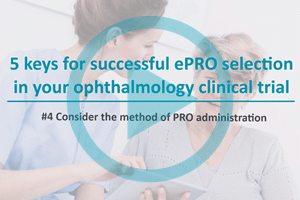Key #1 for successful ePRO selection in your ophthalmology clinical trial: Ensure the ePRO answers the intended clinical endpoint
PROs have become a vital part of modern ophthalmology with an increasing focus on PROs within high-quality ophthalmic trials. International organizations are now significant contributors to the development, access, and guidance for the best use of PROs.
The International Society for Quality of Life Research (ISOQOL) has published recommendations for minimum measurement standards for PROs, intended to promote the appropriate use these measures in patient-centered outcome research and comparative effectiveness research.
The minimum standards include documentation of the conceptual and measurement model, evidence for reliability, validity, interpretability of scores, quality translation, and acceptable patient and investigator burden.
A PRO or ePRO can be used to evaluate:
- A primary endpoint: a vision specific measure such as the National Eye Institute Visual Function Questionnaire (NEI VFQ) is used to measure specific visual impairment symptoms and can assess clinical benefits from treatment. The development of the NEI VFQ, although not the first scale to be validated, was first published in 1998 and remains in its shorter form (NEI VFQ-25), the most widely used vision-related PRO measure in the world.
- A secondary endpoint: can complete or show additional benefits to the primary measure, such as a general health utility measure like the EuroQol – 5 Dimension (EQ-5D), which is not disease specific. The EQ-5D is measured in several ophthalmology studies to support clinical ophthalmology evaluations and monitor the patients’ overall wellbeing.
- An exploratory endpoint: are used to frame future research or explore new hypotheses and are not generally rigorously evaluated for statistical significance. With mobile technology, clinical trials can capture up to daily ePRO measures for their patients. This creates potential for new endpoints that have not been previously possible to assess or improving how we assess existing endpoints.
It is important to carefully select the measure that will answer the intended endpoint, whether it be primary, secondary, or exploratory. Additionally, it is paramount to the study success to match the chosen PRO together with the patients’ capabilities to ensure the PROs can be completed in a timely, accurate and complete manner.
A trial with positive ePRO data, especially when the ePRO is a primary endpoint, can help drive marketing authorizations and labelling claims. A study of drugs approved by the FDA between January 2000 and June 2012 looked at approval of ‘PRO labelling’ (i.e. where the label of the drug included claims of treatment benefit based on the results of a PRO).
Of the 308 drugs approved during this period, 70 were specifically approved for a PRO based labelling claim. Of those with the PRO labelling claim, 57 were based on studies in which the PRO was the primary outcome.
Celeste Sage, Clinical Project Manager @Kayentis
Estelle Haenel, Medical Director @Kayentis
Discover more on successful ePRO selection in your ophthalmology clinical trial:
Follow us on LinkedIn to stay up-to-date with our latest videos:
Last update : 4 February 2020






